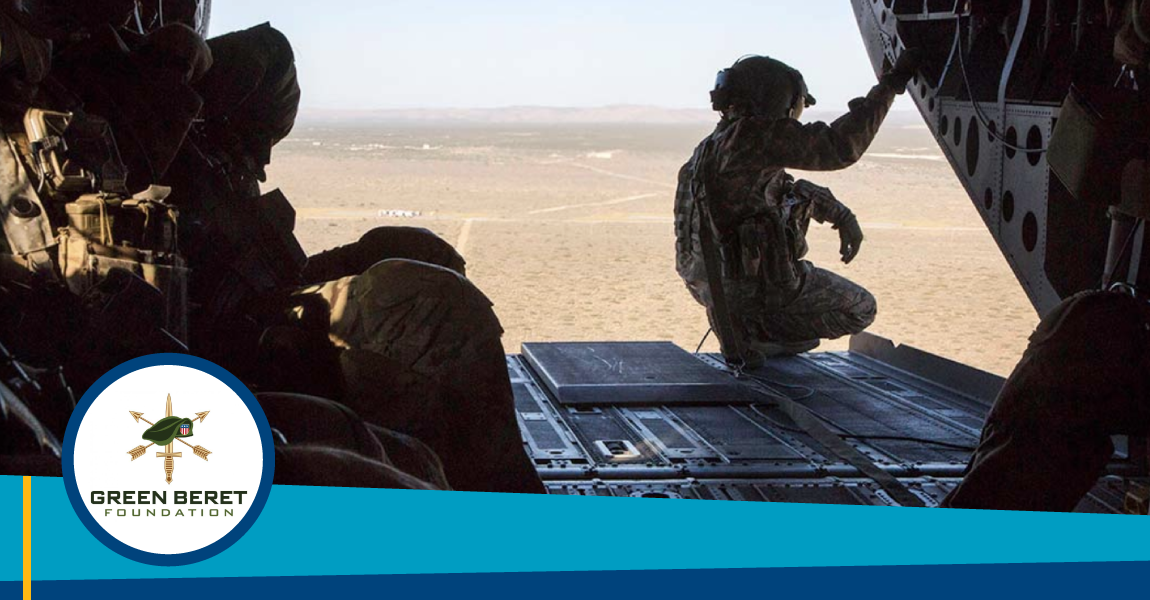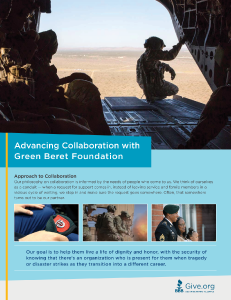
Advancing Collaboration with Green Beret Foundation
About the Organization
At the Green Beret Foundation, we honor our commitment to Green Berets past and present by providing Special Forces Soldiers and their families with emergency, immediate, and ongoing support.
The Green Beret Foundation serves the Army’s Special Forces, our nation’s most elite soldiers. We believe Green Berets are our nation’s greatest assets. Every day, we honor our commitment to Green Berets past and present, as well as their families, by connecting them with the right resources to prosper and thrive. Because when these soldiers meet powerful opportunities, our nation’s most elite soldiers become our nation’s best leaders.
Featured Guest
Frances Arias
Green Beret Foundation
Approach to Collaboration
Our philosophy on collaboration is informed by the needs of people who come to us. We think of ourselves as a conduit — when a request for support comes in, instead of leaving service and family members in a vicious cycle of waiting, we step in and make sure the request goes somewhere. Often, that somewhere turns out to be our partner.
Build Trust
We vet our service and family members, but the same applies to our partners. We vet our collaborators by looking at their metrics, reading their literature, having one-on-one conversations with them, and growing a relationship with trust. We aim to step up and show service members that we provide vetting and we’ve been at this for 10 years. We know what service members need, and we’ll be there for them to assist them in their next steps.
Have a Vision
Our mission and vision have always been to provide tools, resources, guidance, and empowerment to the Special Forces Community – not just for Green Berets – but for their family members as well. Our goal is to help them live a life of dignity and honor, with the security of knowing that there’s an organization who is present for them when tragedy or disaster strikes as they transition into a different career. We operate to fill those gaps of uncertainty by partnering with organizations. Though we provide financial assistance and cover our five core programs, there are often gaps that we can’t reach, and we serve as conduits as we identify and collaborate with clinics, device manufacturers, other 501(c)(3)s who specialize in TBI programs or spinal cord injuries, and more.
Seek to Assure the Success of Your Collaborators
With trust comes effective communication. Often, we see Green Berets who need testosterone therapy. Since Green Beret Foundation is not a clinic, we offer financial assistance and partner with organizations like Mission 22, to look at the service member’s blood work to help us understand other underlying issues — traumatic brain injury or post-traumatic stress. We work with organizations we can advocate for, and put our service members in touch with Mission 22, so they can provide medical access, blood work, prescriptions, and follow-ups with physicians. In turn, we then ask Mission 22 for follow-ups and updates and provide additional financial assistance if needed. We communicate and trust each other well because we’re working towards the same goal. We’re trusting them to provide services, and they’re providing us the follow-up and understanding of what the service members’ additional needs may be.
Take Stock
We’re taking stock of the asset of social media that comes behind retweets, re-posts, and communication about how we’re trying to benefit our community. Last year, we initiated an official survey in which we surveyed the Special Forces Community partnered with the Cleveland Clinic and the Neurosurgery department of the Mount Sinai Icahn School of Medicine. We surveyed the community about traumatic brain injury, post-traumatic stress, spinal cord injury, and exposures – the four critical issues we’ve identified within our community and provide resources for. We’ve been able to publish manuscripts in the journal of neurosurgery and they’re being presented at conferences. By prioritizing transparency, we’re able to build trust by leveraging our relationships with these clinics and show the results to our community.
Start Small
At our foundation, we only have four people who are essentially running global operations. A Green Beret could be anywhere in the world and we’ll try to figure out how to make sure to provide resources for him. We start small and work with each other to understand our limits. We started small with the Mount Sinai survey, and months later, we’ve created the Special Forces Neurosurgery Collaboration. We wouldn’t have the partnership and access to data we have today without first learning who we are, understanding our team, and knowing our expectations before scaling the survey.
The nature of what we do requires several collaborations. We cannot possibly meet the need unless we fill the gaps our services don’t cover; we’re always starting small so we can build feedback loops and stronger partnerships.
Take a Portfolio Approach
We have a wide range of services and focus beyond the scope of the service members’ needs. To better help our clients, we offer resources for the service member’s family as well.
Keep Your Donors Apprised of Your Collaborations
We always post about our collaborative efforts with our organizations on social media. Last year, we partnered with Home Base, an organization that is a conduit of the Red Sox Foundation, and we sent our service members through their traumatic brain injury program. We’ve provided press releases, graphics, and information to share our collaboration with our donors, but also to educate our community about opportunities they can apply for.
This article was composed by Rachel Romana Liu.



